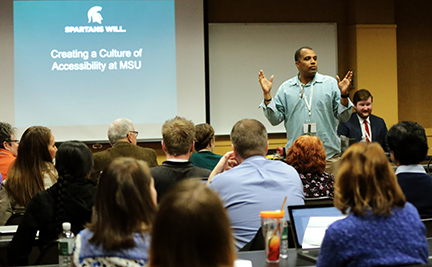White canes. Hearing aids. Leader dogs.
While many of the aids used to enhance accessibility are easy to identify, there’s another layer of access that’s hidden behind the scenes. These digital tools often go unnoticed, even though accessible learning depends on this technology every day.
Students at Michigan State University are working with faculty, staff and administrators to create a culture of accessibility, especially within the College of Communication Arts and Sciences. That’s where students co-founded the ComArtSci Digital Content Accessibility Team (DCAT), to implement accessible technology and universal web design.
“Empathy is a natural human emotion, and when it comes to accessibility, people really do wish to help as much as possible,” said Trenton Bates, a senior in the College of Social Science who interned as an accessibility consultant for ComArtSci. “However, the biggest problem that we face with spreading accessibility is the lack of general knowledge on the subject.”
Creating a Culture of Accessibility
The work to render standard documents and visual content accessible can be difficult and time-consuming. For audio files, it can take hours to listen to content in an effort to transcribe the words. For PDF files, it can be tedious to rework text, images and columns into a format that screen readers can interpret.
“A lot of faculty think, ‘I can’t have my bells and whistles,’” said Bender. “You can. You just need accessible universal design.”
Whether it means captioning videos, boosting color contrast, using plain language or adding headers to text, these steps are vital to providing access for the Deaf, Hard-of Hearing, Blind and other populations. Students may cope with multiple disabilities, too, calling for access to be provided in numerous ways.
With widespread support, Bates worked with Instructional Designer James Bender to shepherd some of the accessibility efforts at MSU. The team started at high levels of administration and faculty, working from the top down, to change the culture in higher education and make it more inclusive. On Dec. 6, 2018, Bender and Bates presented their work at the Accessible Learning Conference, sharing insights on Creating a Culture of Accessibility at MSU.
They described the DCAT strategy, how it ties into the university’s five-year plan, and the scope of the work. Based in IT, DCAT works in three areas to foster better accessibility university-wide: course content, procurement and the web.
“From our perspective, it’s about a culture of inclusive design,” said Bender. “During every year of the five-year plan, we ask people to show how they are changing the culture.”
Change Inside ComArtSci
Tapping the accessibility savvy of student interns, the DCAT team has implemented accessible learning changes with partners across the university.
They have supported the completion of Service Learning Agreements in many units, and made accessibility updates for the library, the provost office and academic governance. The team has also partnered with the College of Social Work, Eli Broad College of Business, the College of Arts & Letters, the College of Natural Science, the Division of Public Health, and ComArtSci, among others.
“ComArtSci is our biggest partner, where we hired the most students to partner with,” said Bender.
Inside ComArtSci, six student interns have been devoting their time in order to provide accessible content for students with disabilities. Working in the dean’s office, they have remediated numerous academic materials and digital content.

The students—and the broader initiative—have received enthusiastic support from accessibility liaisons at the level of department chairs and directors in ComArtSci, putting the power of leadership behind the movement. While colleges and universities sometimes struggle to implement accessible solutions, the obstacles have been cleared for student interns in ComArtSci.
“In ComArtSci, they assuaged that, and they worked from the faculty level and reached out to the higher faculty for support. From the faculty level, it was able to spread much more efficiently and much more organically,” said Bates, who graduates in 2018 with a B.S. in Economics. “If you take an idea to the top level, it’s a lot easier to trickle it down to the lower level.”
The team’s efforts to remediate courses are paving the way for better online and in-person instruction, leading to better learning outcomes for students with a range of disabilities.
As part of their strategy, DCAT is going above and beyond to promote accessibility. The team is not only remediating documents, but they are also creating solutions and maintaining an open line of communication across departments.
They work diligently on outreach, spreading awareness about accessible content and universal design. They offer trainings in groups, one-on-one settings and online via the ComArtSci A11y self-enrollment course, with many resources publicly available. The self-enrollment course is open to any MSU faculty, staff and students with a university ID.
“We give them all of the tools necessary, all of the training documents necessary to get the job done,” said Noah Whitney, who represented the ComArtSci team on a student panel.
Proof that Access Matters
To show the impact of accessibility, interns will often share a story of a student with special needs, explaining that no matter how hard students work on their assignments, one inaccessible piece of content can be a barrier to academic success.
By the close of 2018, they remediated so many courses that the college is entering a new stage—a stage where the accessible content professors need is already created before a new term begins.
“We’re entering a cycle where all the documents will be accessible,” said Nate Evans, manager of digital content and accessibility at MSU. “That’s happening for the first time.”
Using routine accessibility checks, key partnerships across the university and the efforts of the student team, MSU has developed a model that any institution of higher education can use to make accessibility a reality.
“We really wanted to take a grand approach to our accessibility and universal design,” said Bender.
For more information, visit the MSU Web Accessibility Homepage.
By Melissa Priebe
